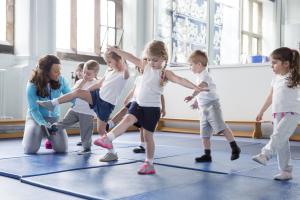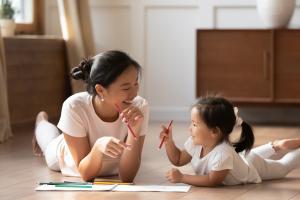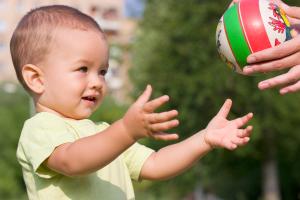Gross motor skills include all of the large movements a child makes with major muscle groups.
It is more complex than it seems and involves the coordination of the muscles and the neurological system, which impacts balance and coordination. It also forms the basis for fine motor skills that help us make small movements like using a pencil.
Gross motor skills are related to other abilities.
These include:
- balance
- body awareness
- coordination
- physical strength
- reaction time.
Having poor gross motor skills can impact people in all areas of life. It can make it hard to do key tasks at school, work, and home.
Difficulty with motor skills can also take a toll on self-esteem.
Balance

Balance is important to ensure a child can safely move their body from one position to another.
It is required for many tasks including walking, riding a bike and getting dressed.
Sometimes children can have difficulty with balance.
How it presents
The child:
- trips often when walking or running
- finds it difficult to manage new environments or uneven surfaces
- is unable to stand on 1 leg for a few seconds by age 4
- performs poorly within PE lessons or sports.
How you can help
Get your child to:
- regularly play in outside spaces including in the garden or playground, with different surfaces
- engage in a range of activities on the play apparatus such as climbing frames and balance beams
- play in soft play spaces which allows for practice in a safe environment
- engage in regular sports such as swimming, dance, gymnastics, or martial arts classes
- play activities that promote balance including stepping-stones (you can make your own), trampolines and hopscotch
- walk along a straight line
- play 'catch' in different positions such as kneeling, standing with their feet together and standing on one leg.
Postural control and core stability

Postural control and core stability are the ability to maintain body postures such as good sitting posture.
This comes from having strong muscles around the torso (stomach, back and hips) to keep the body upright and allow for movements of the arms, legs and head.
How it presents
The child:
- has difficulty standing upright in their seat
- leans on furniture or on their hands when sitting on the carpet
- has difficulty with holding postures against gravity
- has difficulty with fine and gross motor tasks
- can find it difficult to concentrate.
How you can help
There are a range of activities that encourage improved core support including:
- completing activities lying on the stomach such as lying on the stomach to read, draw or watch TV
- animals walks such as crab walks, seal walks, frog walk or bear walks. Encourage the child to do this in a slow and controlled way
- lying on the stomach and stretching out like Superman - lift up your arms and legs into the air and hold it for as long as you can
- the popcorn position: laying on your back, lift your knees up to your chest, hold them with your arms and raise your head to your chest, hold it for as long as you can
- the bridge position: laying on your back, bend your knees and bring your feet under your knees whilst raising your bottom off the floor, hold it for as long as you can
- wheelbarrow walks.
Bilateral integration and midline crossing

Bilateral integration is important to be able to coordinate both sides of the body together to complete tasks that require 2 hands such as doing up shoelaces or cutting with scissors.
Midline crossing is being able to cross the middle of the body with the other side.
How it presents
The child has difficulty completing tasks such as:
- tying shoelaces
- doing up buttons
- cutting with scissors
- using a knife and fork together
- opening packets
- threading beads
- using the right hand for things on the right side, and the left hand for things on the left side.
How you can help
The following activities can help your child improve their Bilateral integration
- hand-clapping games
- cutting with scissors - start with simple cutting tasks and encourage the child to turn the paper as they are cutting
- threading activities such as threading beads or pasta. Start with larger sized beads initially
- hiding objects in theraputty or play-dough for the child to search for
- construction activities such as Lego, Duplo or Meccano
- craft activities such as using stamps, tracing stencils, using a ruler
- opening jars and containers
- lacing cards
- sorting activities and using one hand at a time to sort items into containers placed on both sides of the body
- placing coins on different parts of the table and asking the child to post all the coins using one hand and then swap hands.
Motor planning

Motor planning is the ability to plan out a movement and then carry out this movement. The ability to motor plan is necessary for us to respond to our changing environments.
How it presents
The child may:
- find it difficult to time or anticipate a movement such as catching a ball
- appear slow at tasks, especially new tasks
- appear clumsy and trip, fall or bump into things
- need more practice than other children to learn new tasks
- have difficulty when copying movements from others
- use too much or too little force to complete tasks.
How you can help
Break down tasks into small steps and practice one at a time
Give simple, one-step directions. If the child cannot follow the directions, demonstrate. If he is still unable to do the task take his body through the motions so he feels what it is like to do the task.
Do not keep repeating the same directions if they cannot follow them. They will just get frustrated and confused.
You can also:
- practice activities such as Simon Says, animal walks and climbing on playground equipment
- make your own obstacle course with things to climb under, over and through
- Body alphabet – making your body into different letters
- practice Yoga movements
- do paper folding activities such as simple origami
- do pencil control activities.
Eye-hand coordination

Eye-hand coordination is the body's ability to process information received through the eyes and use it to direct movements of the hands in both fine and gross motor tasks.
How it presents
The child may:
- have difficulty with colouring within the lines
- have difficulty hitting, kicking or catching a ball
- lack drawing skills and have messy handwriting
- avoid fine motor tasks or sports.
How you can help
Activities you can try to help your child include:
- fine motor activities such as colouring in the lines, connecting dots and tracing on the line
- ball sports including kicking and catching. Start with larger sized balls and stand close initially to support the child to succeed prior to increasing the difficulty
- keeping up a balloon
- puzzles
- sports such as tennis and cricket
- hopscotch and juggling.
You should also consult your GP to check your child's eyesight.